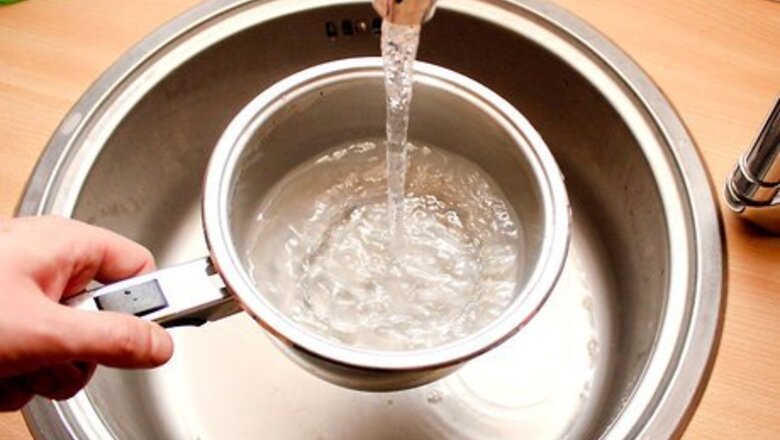
views
X
Research source
Luckily, there are easy methods that you can use to clean copper, aluminum, or cast iron kitchenware with soap and water or commonly found household ingredients. With the right knowledge you'll have spotless kitchenware in no time!
Washing by Hand

Fill your pot or pan ⅓ of the way with hot water. Hot water is effective at removing stuck on food and stains. You shouldn't put non-stick, cast iron, or aluminum pots and pans in a dish washer. Putting your pots and pans in the dishwasher may scratch and damage them.

Put two drops of mild dish soap in the water. Mix the soap and water together until the dish soap starts to sud. You can use dish soap on most materials like copper, stainless steel, aluminum, and non-stick pots and pans. Avoid washing cast iron with soap or it may affect the taste of your food.

Scrub the inside and outside of the pot or pan with a sponge. Let hot water and soap sit in the pot or pan for a few minutes first. Then, concentrate on spots that have stuck-on food or areas that are particularly dirty. Do not use abrasive sponges or steel wool to clean non-stick or stainless steel pots because you can scratch them.

Rinse the pot or pan with hot water. Hold the pot or pan under the faucet until you rinse away all the remaining soap suds. If you don't rinse your pots or pans thoroughly, your food may taste like soap.

Dry the pot and pan. Rub the inside and outside of the pot or pan with a rag until it's completely dry. You can also dry the pot or pan on a drying rack.
Cleaning Copper Pots and Pans

Place the pot or pan in the sink and cover it in table salt. Pour enough salt on the inside and outside of the pot or pan so that there is a thin layer that covers the entire surface of the copper kitchenware. Table salt will act as an abrasive and will help you scrub problem areas on your pots and pans.

Pour white wine vinegar over the salt. Pour enough vinegar over the salt to wet down the pot or pan. Don't pour too much or you’ll rinse away the salt. The acidity in the vinegar will start to break down the tarnished areas in the copper.

Let the vinegar and salt sit on the pot or pan for 30 seconds. As the solution sits on the pot or pan, you should see tarnish and stains start to fade away. If you don’t have white wine vinegar, you can use fresh lemon juice as an alternative.

Scrub the pot or pan with a sponge soaked in white vinegar. Pour enough white vinegar onto a sponge to fully saturate it. Take the sponge and scrub back and forth on the inside and outside of the pot, concentrating on especially dirty spots. As you do this, dirty and tarnished areas should start to become shiny. Sprinkle more salt on problem areas.

Rinse the pot or pan with hot water. Spray down the pot or pan under the faucet until there are no more traces of vinegar or salt on your copper kitchenware.

Dry the pot or pan with a rag. Rub over the inside and outside of the pan, making sure to pick up all the remaining moisture from the cookware.
Cleaning Aluminum Pots and Pans

Pour three parts water to one part white wine vinegar into the pot or pan. Mix the solution with a spoon or a fork until it becomes well incorporated. The acidic vinegar will clean dirty and tarnished areas on the aluminum.

Bring the solution to a boil on the stove top. Turn your stovetop to high and bring the mixture to a boil. Let the solution boil for a minute. Your pot or pan should already start looking cleaner.

Add 2 tbsps (15.62 g) of baking soda to the pot or pan. Take the kitchenware off the heat and place it into your sink. Pour the baking soda into the pot or pan. It should start to fizz and react to the vinegar and water solution. Let the baking soda sit in the pot or pan until it stops fizzing, then pour it out into your sink.

Scour the pot or pan with a sponge. Use a non-abrasive sponge to scour the inside and outside of the pot or pan. Add more water and baking soda to especially troublesome areas until the pot or pan looks shiny.

Rinse the pot or pan. Hold the pot or pan under the sink and run hot water from the faucet. Continue rinsing it until all of the baking soda and vinegar solution is removed from the pot or pan.

Dry the pot or pan. Wipe down the inside and outside of the pot with a cotton rag or paper towels. Continue to wipe the kitchenware until it’s completely dry.
Cleaning Cast Iron Pots and Pans

Wash the pan with hot water and a sponge. Rub back and forth over the surface and interior of the pan. Take notice of places that have stuck on food. If you clean the cast iron immediately after using it, most foods will come off fairly easily. This method of cleaning should retain the seasoning on your cast iron skillet. Don't soak your cast iron or leave it in the sink or it may rust.

Scrub kosher salt into the pan. If there are areas on the pan that have stuck-on food, sprinkle some table or sea salt over the food and scrub it down with a sponge. The salt will act as an abrasive and will help remove the food from the pot or pan.

Rinse the pot or pan. Run the pan under your faucet and rinse all of the food particles off the pot or pan. If you notice that there's still stuck on food, sprinkle more salt and continue scrubbing.

Dry the pan thoroughly. Once the pot or pan is clean, use a cloth or rag to dry it. Remove all moisture from the cast iron before storing it.




















Comments
0 comment